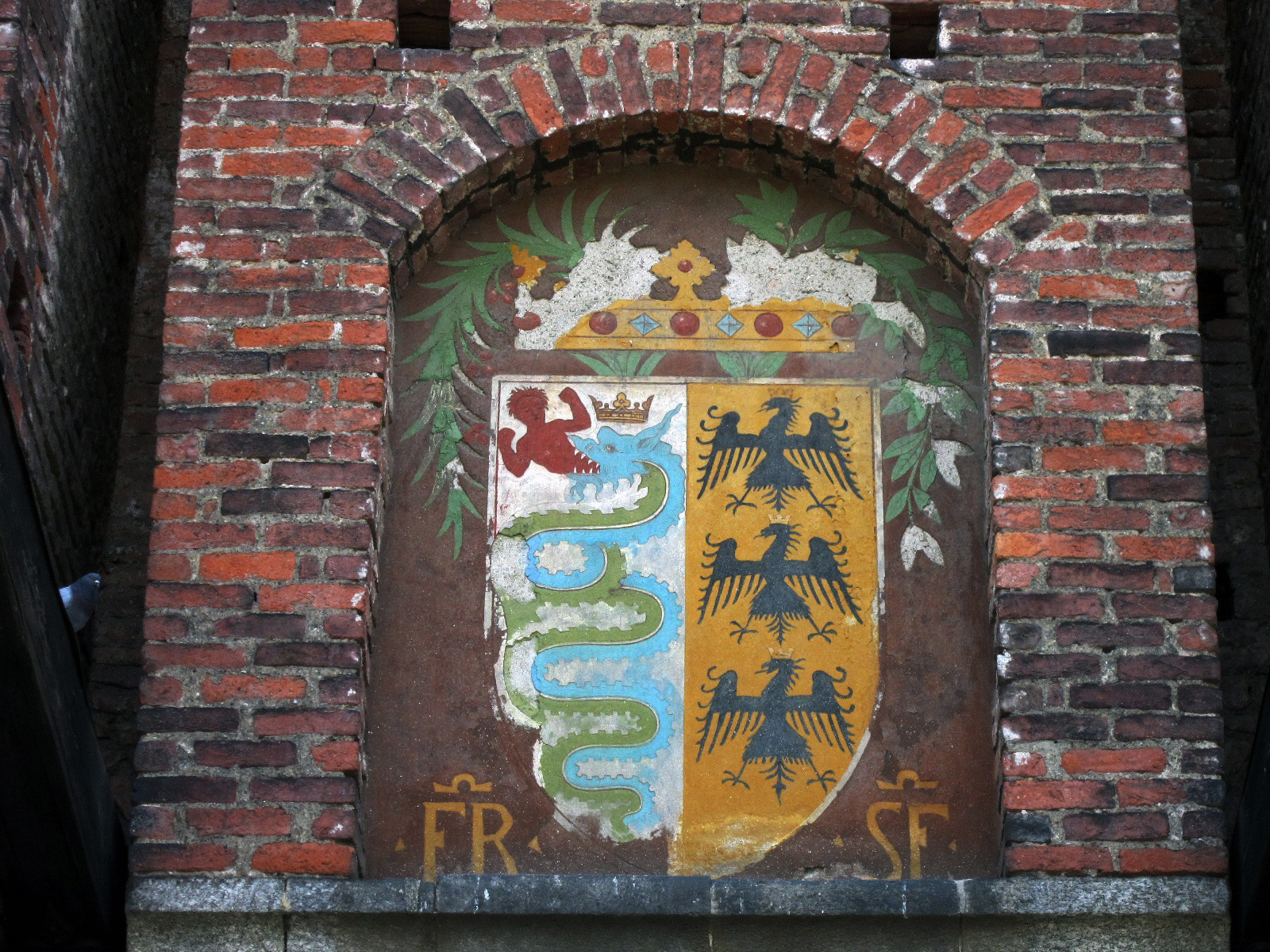 According to the legend, when a tribe of Gauls defeated the local Etruscans here, they wanted to settle in the area and sought the advise of an oracle who told them to built a settlement in the spot where they’d find a sow half covered in wool. No one really knows if this was a wooly pig or a pig in a blanket but whatever, the Gauls settled the area now known as Milan. When the Romans claimed it they referred to the settlement as Mediolanum or half wool in reference to the wooly pig. Over the years, the name was shortened to Milan. So there you have it.
According to the legend, when a tribe of Gauls defeated the local Etruscans here, they wanted to settle in the area and sought the advise of an oracle who told them to built a settlement in the spot where they’d find a sow half covered in wool. No one really knows if this was a wooly pig or a pig in a blanket but whatever, the Gauls settled the area now known as Milan. When the Romans claimed it they referred to the settlement as Mediolanum or half wool in reference to the wooly pig. Over the years, the name was shortened to Milan. So there you have it.
Somewhere in this city is a carved stone relief of the wooly pig. We’re looking for it but it might take more than one visit.
The bus from the Airport to the Center of Milan costs €7.50 euros a person, 12 Euros for the round trip ticket. It’s a comfortable ride to the Milan Centrale Train Station but can take anywhere from 35-60 minutes depending on the traffic. The buses come to either terminal 1 or 2 of the airport. The train (€11 per person) is another option but it only goes to Terminal 1, which is another bus ride away from terminal 2. We’ve arrived to Terminal 2. The train is only 30 minutes but after waiting for the bus to the other terminal (yes, it is way too far to walk) it ends up taking the same amount of time. We did it both ways, bus into the city, train going back. If you would rather pay 85 Euros you can get a taxi, but that just seems like a silly idea. The bus is actually very comfortable. This is not your typical municipal transportation.
Milan is Italy’s second city, at least according to the citizens of Rome. According to the Milanese it’s the first city. After all, the industry is here, the fashion is here. Unlike most of Italy, the Milanese are driven by accomplishment and wealth. It almost seems like they’re from another country. Maybe the close proximity to France and Germany kicked this city into a higher gear. It’s definitely different from the laid back Italy we’re used to.
Towards the end of the Roman Empire, Diocletian moved the Capital of western empire from Rome to Medilanum. It might have stayed here but Guiseppe Mazzini and the other architects of the Italian unification had a bug up their collective ass to make Rome the Capital. And that’s what happened.
Milan has also been the cradle of Political movements of the 20th and 21st centuries. Once again, the money rules the politics. Mussolini’s Fascism began in here in the 1920’s and ended here in 1945 when Il Duce was hung by his feet at a Milan petrol station after being killed by the partisans.
Milanese entrepreneur and Prime Minister Silvio Berlusconi is from Milan. His empire includes Italy’s largest media group, one of the country’s largest banking and insurance corporations, the leading Italian publicity and advertising agency, the largest publishing house and the political party “Forza Italia”. He’s been indicted for Mafia connections, tax fraud, bribery, corruption, prostitution and sex with minors. But it’s politics as usual in Italia. He always goes free.
On December 13th 2009 at a political rally in Milan’s Piazza del Duomo, a spectator hurled an alabaster statue of the Duomo at Berlusconi and broke his nose and two teeth. Most people say the man who tossed the statue was a mentally disturbed, but the historical image of Mussolini rising and falling in Milan is haunting.
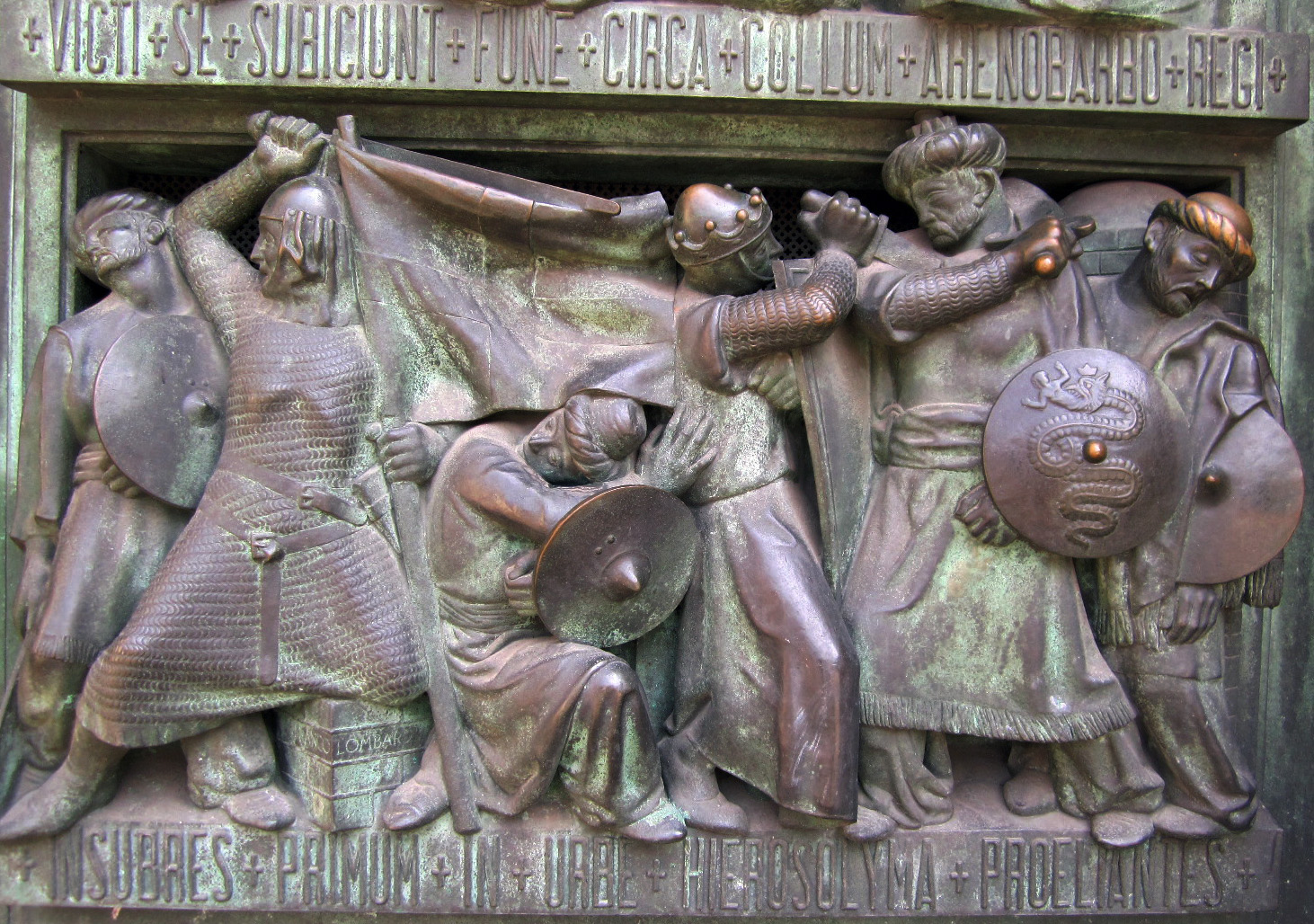 It’s interesting that the symbol of the city is a giant serpent devouring a man. No one really knows what it means but it’s been the crest of the city since the 12th century when during the 2nd crusade, Duke Ottone Visconti killed a very large Saracen and appropriated his shield as a trophy. The serpent relief came from the Muslim’s shield. When he brought the shield back to Milan he proclaimed it to be a serpent devouring a Muslim and put it up on the wall of the castle.
It’s interesting that the symbol of the city is a giant serpent devouring a man. No one really knows what it means but it’s been the crest of the city since the 12th century when during the 2nd crusade, Duke Ottone Visconti killed a very large Saracen and appropriated his shield as a trophy. The serpent relief came from the Muslim’s shield. When he brought the shield back to Milan he proclaimed it to be a serpent devouring a Muslim and put it up on the wall of the castle.
The symbol, known as the Biscione represented the Visconi for over a thousand years. After that, it was passed onto the Sforza family (who followed the Visconti). These days it’s the seal of the city of Milan, the emblem of the football club Inter (Internazionale), the seal of the espresso machine maker Bezzera and the logo of the automaker Alfa Romeo. It’s a pretty recognizable, even though no one seems to be able to explain what it is.
We’re staying at the Town House 33, a small hotel in a residential part of the city. It’s about a 20-minute walk from the Duomo, or there’s a metro stop about 10 minutes away. Milan has a very good Metro system. There are a lot of Liberty style buildings in this neighborhood. Lo Stile Liberty is the Milanese art nouveau style of the early 20th century. The style got its name from Liberty’s department store in London (which still exists). Liberty’s was a big supporter of the art nouveau movement and a lot of their merchandise was exported to the wealthy patrons from Milan. Liberty Style is kind of relaxed art nouveau, not as embellished as the French version or the American Art deco or Spanish Modernism, or Austrian Secession or Germany’s Jugenstil. It seems to be making a resurgence though. A lot of the buildings are getting restored and they look great.
The hotel is comprised of two 19th century apartment buildings (Town House 31 and 33) connected together into a very comfortable setting. The rooms are good size, very contemporary and the staff is extremely attentive. In the morning we all sit at a long communal table for breakfast. The rest of the day, the guests like to sit at the communal table and click away on their laptops. We join in and feel right at home. Thank you Alli, Alvin and both Elenas for a wonderful stay.
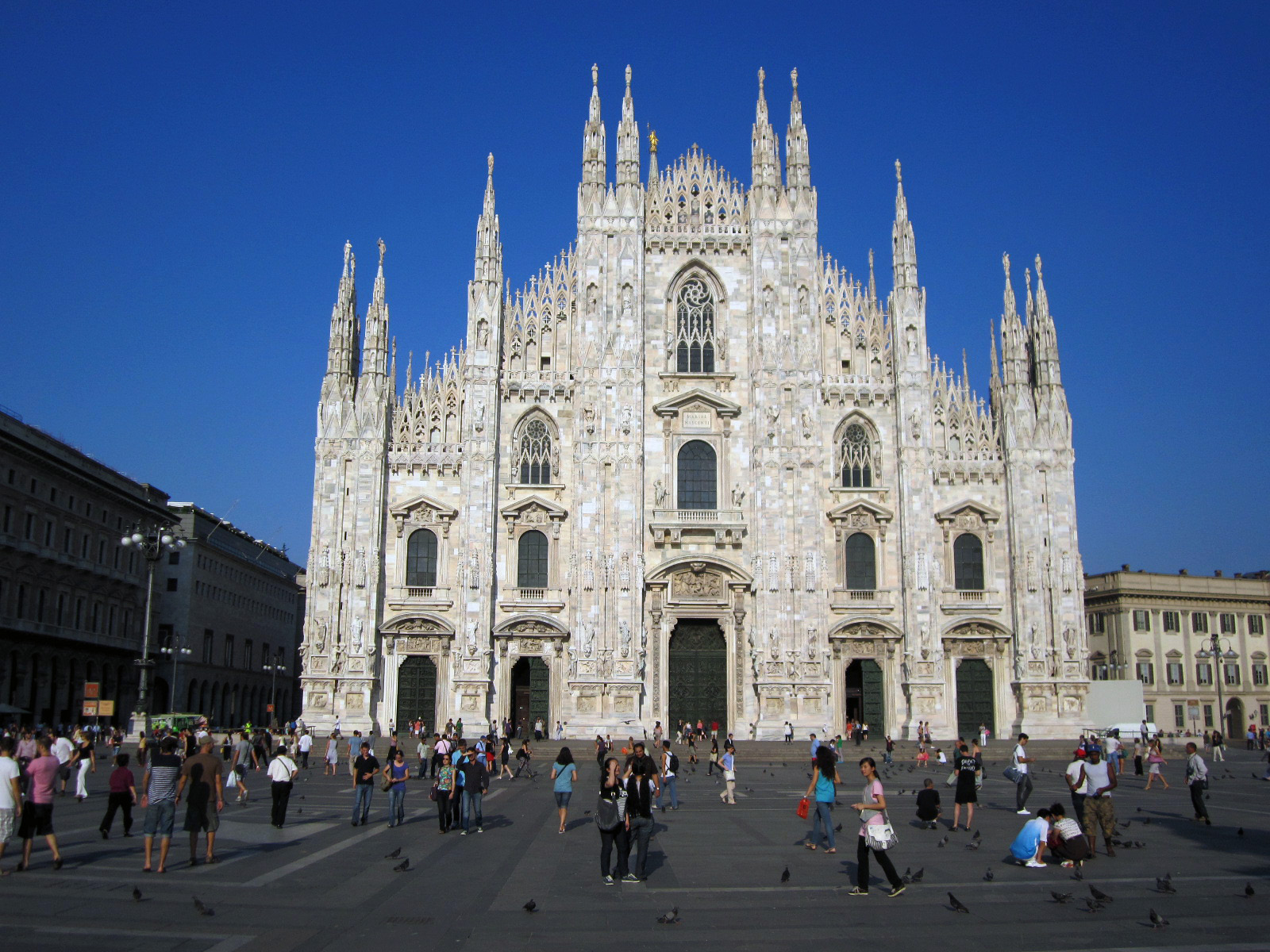 Everything in this city seems to gravitate around the Piazza del Duomo and the Duomo of Milano, a big pink and white oogily-googily monstrous 357 ft tall spire Gothic Cathedral.
Everything in this city seems to gravitate around the Piazza del Duomo and the Duomo of Milano, a big pink and white oogily-googily monstrous 357 ft tall spire Gothic Cathedral.
To one side is the famed shopping of the Golden Quadrangle, the shopping area bordered by Via Monte Napoleone, Via della Spiga, Via Sant’Andrea and Via Borgospesso. Every famous designer (and some not so famous) is represented here.
July is great month for sales in Europe but even the sale prices are still pretty pricey. It was a lot of fun looking in the windows, but that was pretty much all we did.
Sant’Ambroglio (Saint Ambrose, the Patron Saint of the city) supposedly started the foundations of the Duomo but most of the construction came from the 14th century money belt of Gian Galeazzo Visconti who filled his treasury with booty after conquering all of northern Italy and Tuscany in an attempt to unify Italy. It was a good attempt, but the unification was still 500 years away.
Gian Galeazzo wanted to build the biggest church in the world and most of the money he profited from the wars went into the Duomo. Unfortunately though, he never got to see it finished. He died in 1402, only 16 years after he started the project.
Gian Galeazzo dedicated of the Cathedral to the Mother Mary, hoping that she would favor him with a male heir. Two years after the invocation, in 1388, the Heir, Gian Maria Visconti, was born. However, he was hardly the son Gian Galeazzo had wished for. Gian Maria was a bad kid who grew into a worse adult. He was known to release his attack dogs on innocent people, killing them for entertainment. Needless to say, Gian Maria was assassinated at age 24. But back to the Duomo.
Gian Galeazzo Visconti assembled some of the greatest talents from France, Germany and Italy and what this committee of international stars came up with is one of the most bizarre looking Cathedrals in the World. The exterior is crowned with 135 spires, each with it’s own statue. There are over 2000 statues on the exterior and over 700 more in the interior. Counting the statues of the reliefs and cornices and niches, I read there are over 3400 in all. It’s hard to get a feel of what’s going on, inside or outside.
 The reliefs tell various stories; biblical scenes, the story of Jesus, the tower of Babel, the story of the Visconti defeat of the Saracens, the Christian conquest of the known world and references to Sant’Amroglio whipping the Aryan heretics with a cat of nine tails. Sant’Ambroglio was known for his eloquence with words and, as the legend goes, when he was an infant in his cradle a swarm of bees flew into his mouth and left a drop of honey. But for some reason we only see images of him are whipping the heretics into submission. But back to the Duomo..
The reliefs tell various stories; biblical scenes, the story of Jesus, the tower of Babel, the story of the Visconti defeat of the Saracens, the Christian conquest of the known world and references to Sant’Amroglio whipping the Aryan heretics with a cat of nine tails. Sant’Ambroglio was known for his eloquence with words and, as the legend goes, when he was an infant in his cradle a swarm of bees flew into his mouth and left a drop of honey. But for some reason we only see images of him are whipping the heretics into submission. But back to the Duomo..
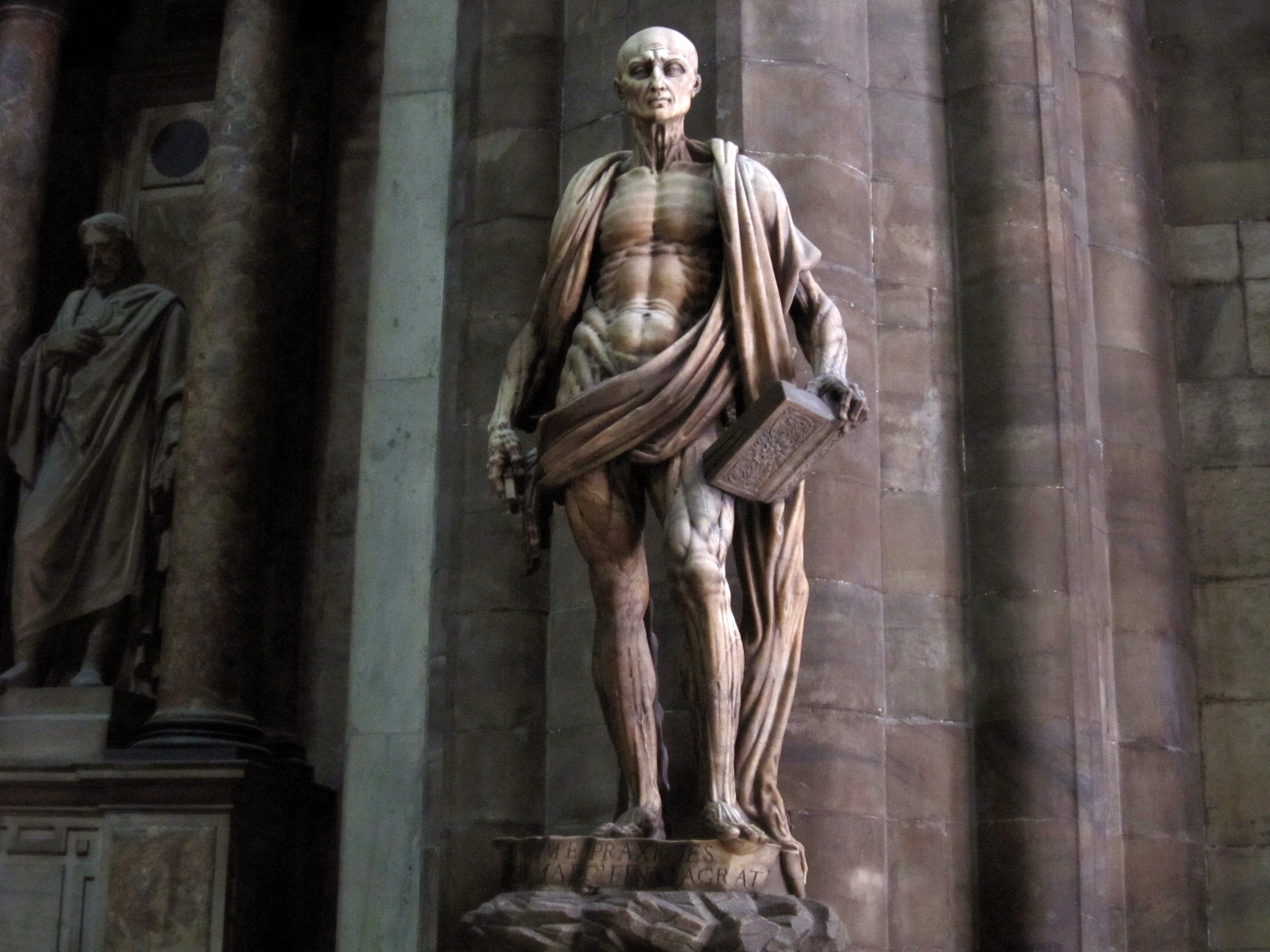 The interior of the Cathedral is dark and oppressive. There is no Joy or Paradise in this tomb of prayer. One of the centerpieces is the statue of St Bartholomew, one of the twelve apostles of Jesus who was martyred by being skinned alive.
The interior of the Cathedral is dark and oppressive. There is no Joy or Paradise in this tomb of prayer. One of the centerpieces is the statue of St Bartholomew, one of the twelve apostles of Jesus who was martyred by being skinned alive.
In the Duomo, his likeness has his skin draped over his shoulders as if it was a trendy fashion statement. It’s bizarre, haunting, and, well, the statue is only a few blocks from the fashion houses of the Golden Quadrangle.
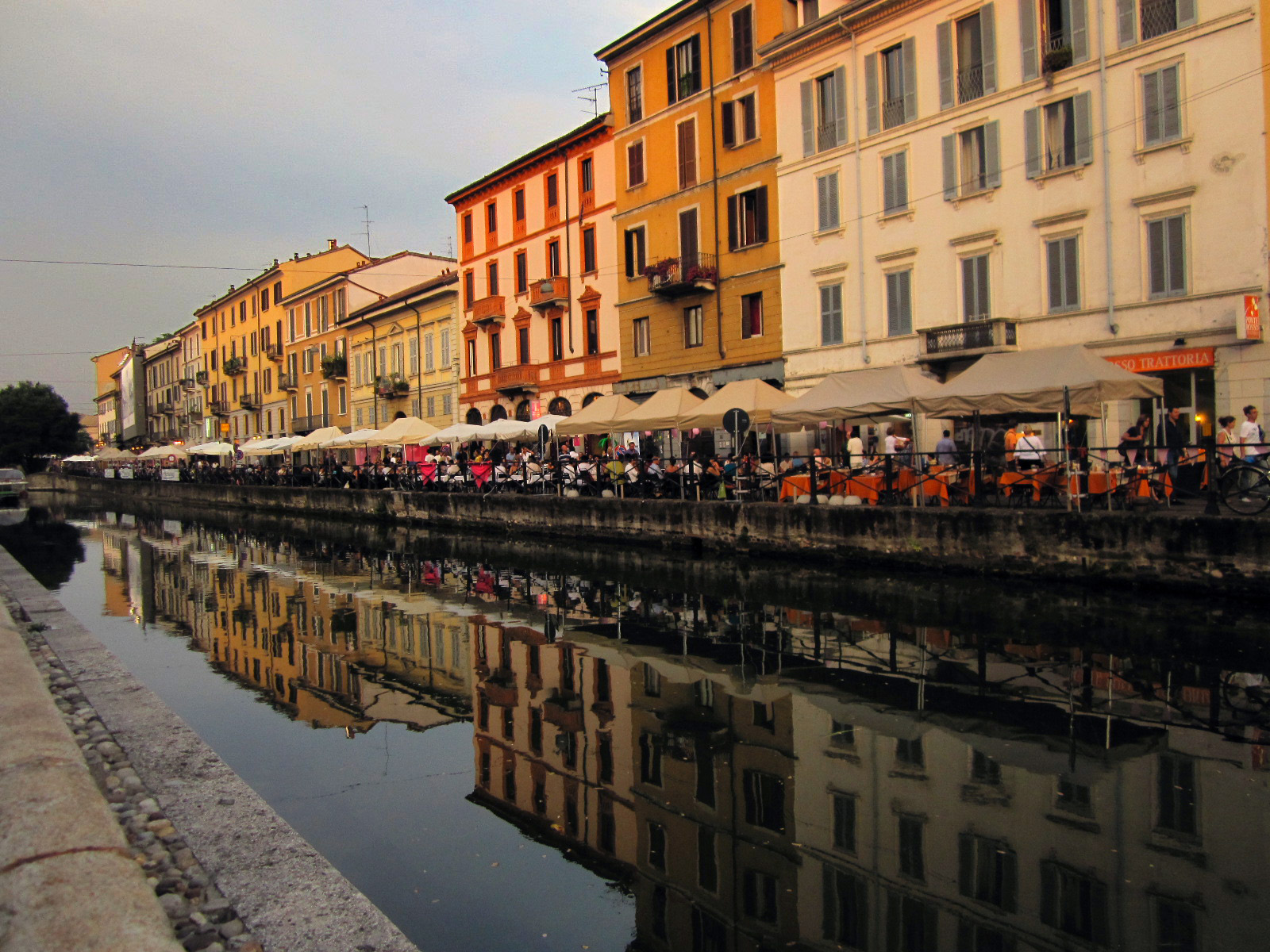 Miles of canals and roads were constructed just to bring the beautiful pink marble from Candoglia on Lake Maggiore into Milan for the building of the Duomo. These canals (the Navigli) served as a major hub of trade in and out of Milan until the 1950’s. Now they’re incorporated into the Navigli district, the place to go for beer, tapas and dinner. The bars get going around 5pm and probably keep going till 5am. We had dinner there one night and left around 11:30pm. It looked like the party was just starting.
Miles of canals and roads were constructed just to bring the beautiful pink marble from Candoglia on Lake Maggiore into Milan for the building of the Duomo. These canals (the Navigli) served as a major hub of trade in and out of Milan until the 1950’s. Now they’re incorporated into the Navigli district, the place to go for beer, tapas and dinner. The bars get going around 5pm and probably keep going till 5am. We had dinner there one night and left around 11:30pm. It looked like the party was just starting.
But back to the Duomo..
Once Gian Galeazzo died, work on the Duomo slowed to a crawl for the following 300 years. Personally, I think the design was so bad; the successive rulers had a hard time putting money into it. By 1762, Gothic churches had gone out of style and the Milanese wanted more changes to modernize the still unfinished mess.
In Amsterdam of the 1970s, an enormous monstrosity of concrete, steel and stone was constructed in the center of the city. It was unaffectionately called the Maupoleum (after Maup Caransa the businessman who put together the funding). It was so ugly and so hated; the citizens of Amsterdam finally got the city to tear it down 20 years after it went up. I have a strong feeling that the Milanese of the 18th century felt the same way about the Duomo, but it’s hard to tear down a Cathedral that was in it’s 400th year of construction.
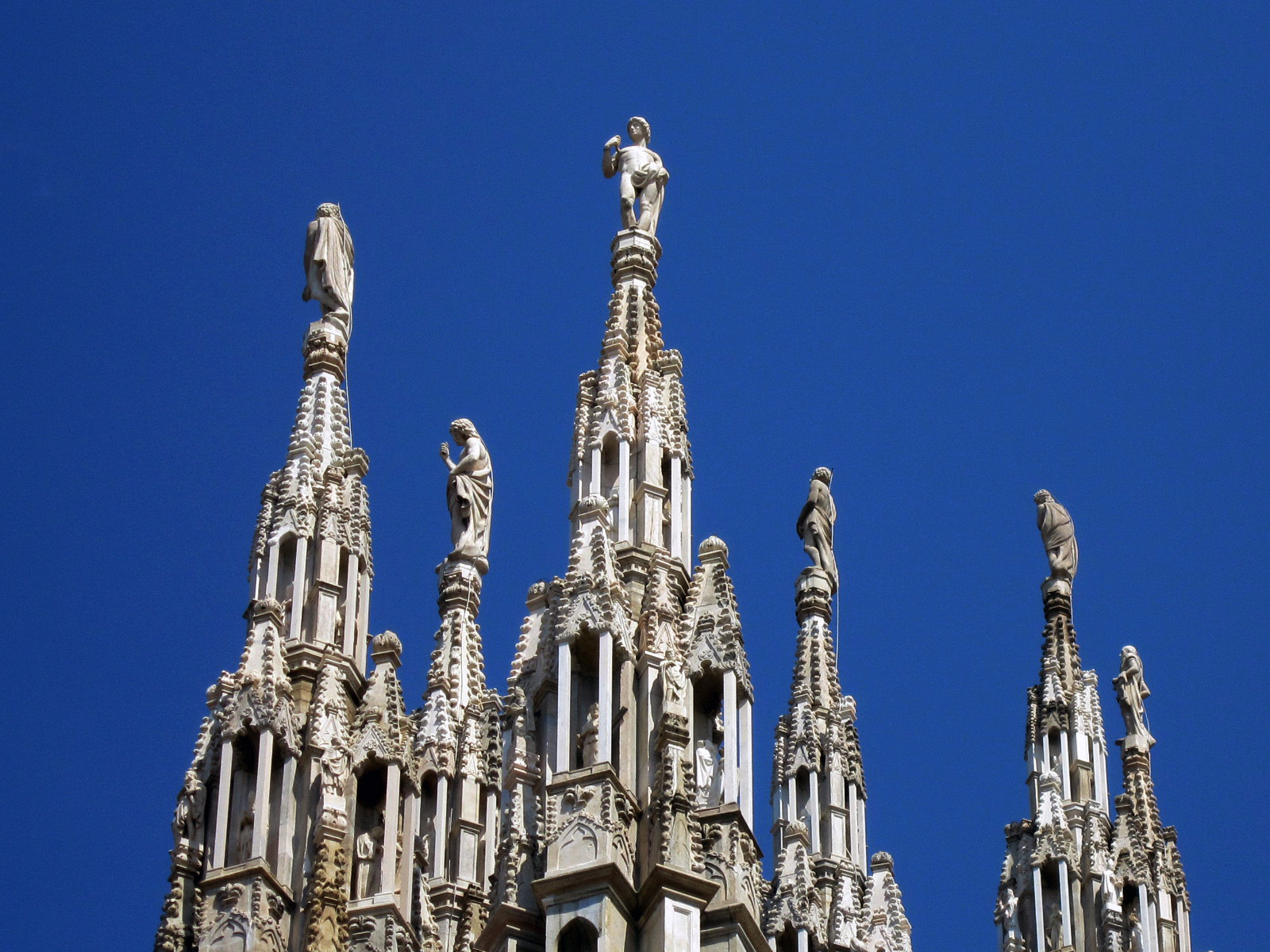 No one could really figure out how to complete it. Everyone just argued about the designs. Then, on May 20, 1805 Napoleon ordered its completion for his coronation as King of Italy. It took an Emperor to make the decision. To mark the great day, he also was rewarded with his own statue somewhere up there on one of the 135 spires. We tried to find him. We went up to the top of the Rinascente Department Store and sat on the roof terrace for a small lunch, but even with a 7x power monocular we couldn’t tell Napoleon from any other statue. Maybe Napoleon was disguised as a classical figure like he is over at the Brera Gallery, but that’s another story I’ll get into later. Back to the Duomo..
No one could really figure out how to complete it. Everyone just argued about the designs. Then, on May 20, 1805 Napoleon ordered its completion for his coronation as King of Italy. It took an Emperor to make the decision. To mark the great day, he also was rewarded with his own statue somewhere up there on one of the 135 spires. We tried to find him. We went up to the top of the Rinascente Department Store and sat on the roof terrace for a small lunch, but even with a 7x power monocular we couldn’t tell Napoleon from any other statue. Maybe Napoleon was disguised as a classical figure like he is over at the Brera Gallery, but that’s another story I’ll get into later. Back to the Duomo..
When Napoleon was defeated and Milan was returned to the Milanese, work resumed on the Cathedral. The Milanese still weren’t satisfied and had to tinker with it a little more. In fact the actual date of completion is listed as 1965. The date the restoration of the Cathedral began is listed as 1966.
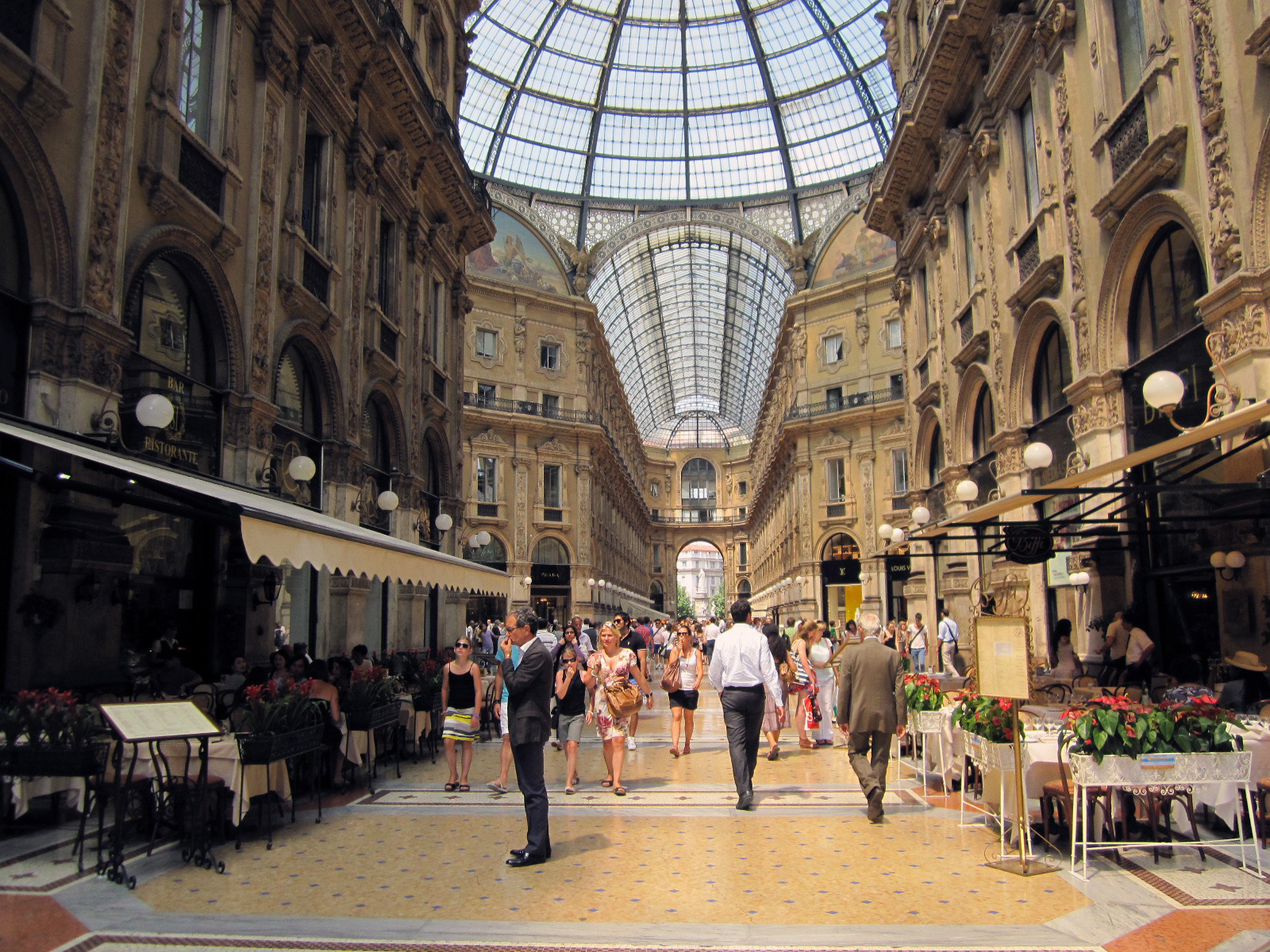 The Piazza del Duomo is a fabulous square, surrounded by porticos and filled with people day and night. For us (and many others), the highlight of the Piazza is the grand Galleria Vittorio Emmanuele II , a beautiful 19th century shopping mall, named after the first King of United Italy.
The Piazza del Duomo is a fabulous square, surrounded by porticos and filled with people day and night. For us (and many others), the highlight of the Piazza is the grand Galleria Vittorio Emmanuele II , a beautiful 19th century shopping mall, named after the first King of United Italy.
The completion of the Italian unification was in 1870. The Galleria opened in 1878. The only bump in the grand opening was when the Galleria designer, Giuseppe Mengoni was inspecting the 48m (157’) tall glass roof on the day before the opening and slipped and fell to his death.
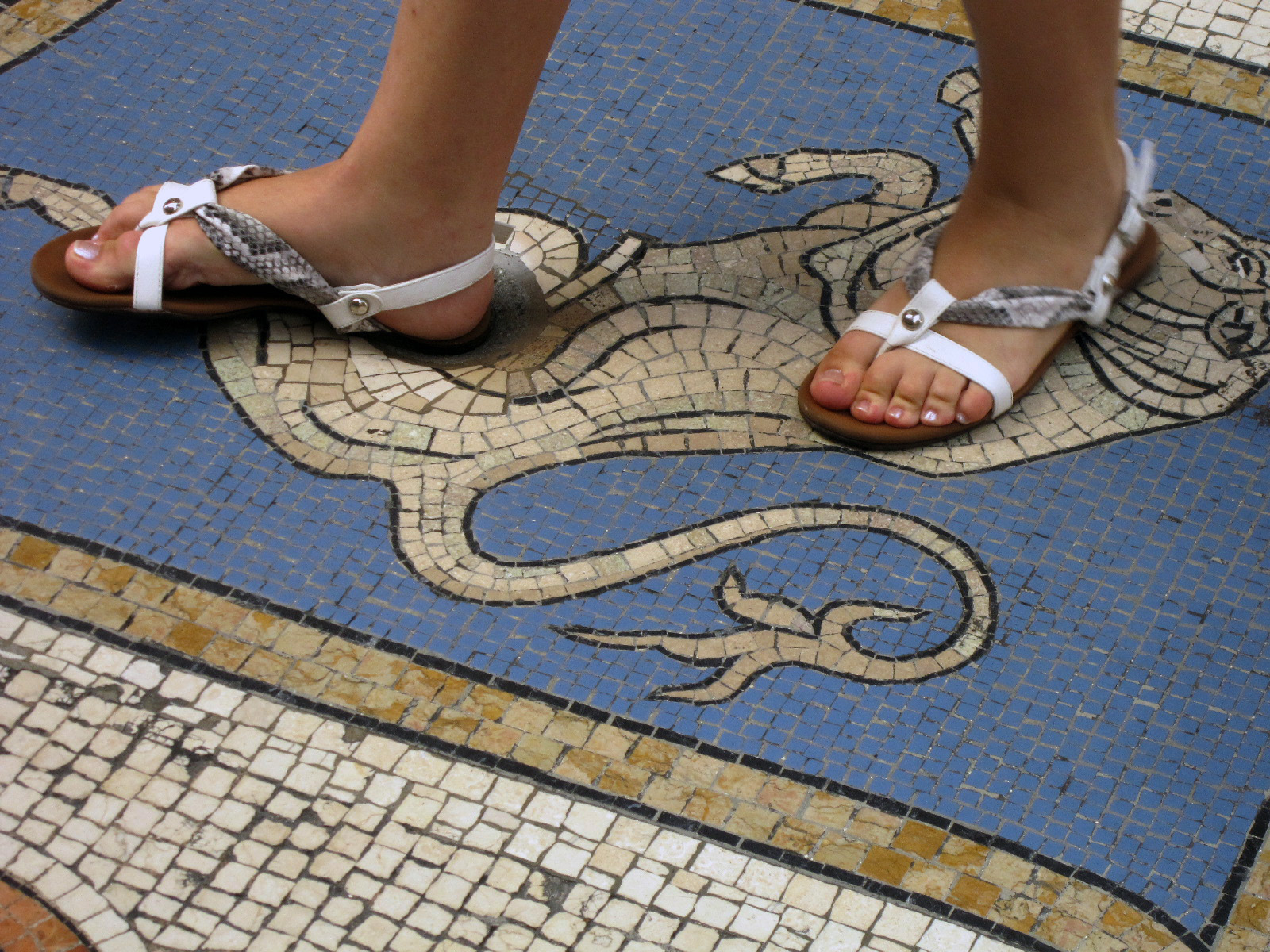 In the center of the Galleria, on the beautiful inlaid mosaic floor, is the image of a bull. For some reason the Milanese think it’s good luck to stand on the testicles of the bull and twirl yourself around three times. There is a hole in the mosaic from all the twirling over the years. We still don’t know the origin of the “good luck” twirl but it’s a magnet to all, locals and visitors. You literally have to wait in line to stand on the bull’s testicles.
In the center of the Galleria, on the beautiful inlaid mosaic floor, is the image of a bull. For some reason the Milanese think it’s good luck to stand on the testicles of the bull and twirl yourself around three times. There is a hole in the mosaic from all the twirling over the years. We still don’t know the origin of the “good luck” twirl but it’s a magnet to all, locals and visitors. You literally have to wait in line to stand on the bull’s testicles.
The Galleria connects the Piazza del Duomo to the Piazza Della Scala, the home of the greatest Opera house in the world (so say the Milanese). The 2800 seat Opera House sits on the site of the church of Santa Maria alla Scala. It might no longer be a house of god any longer, but it’s still a house of worship.
La Scala opened in 1778. Between 2002-2004 the theatre was renovated to the tune of 61 million dollars: new stage, more room backstage and a new electronic libretto system that put the supertitles onto monitors by the seats instead of over the stage proscenium.
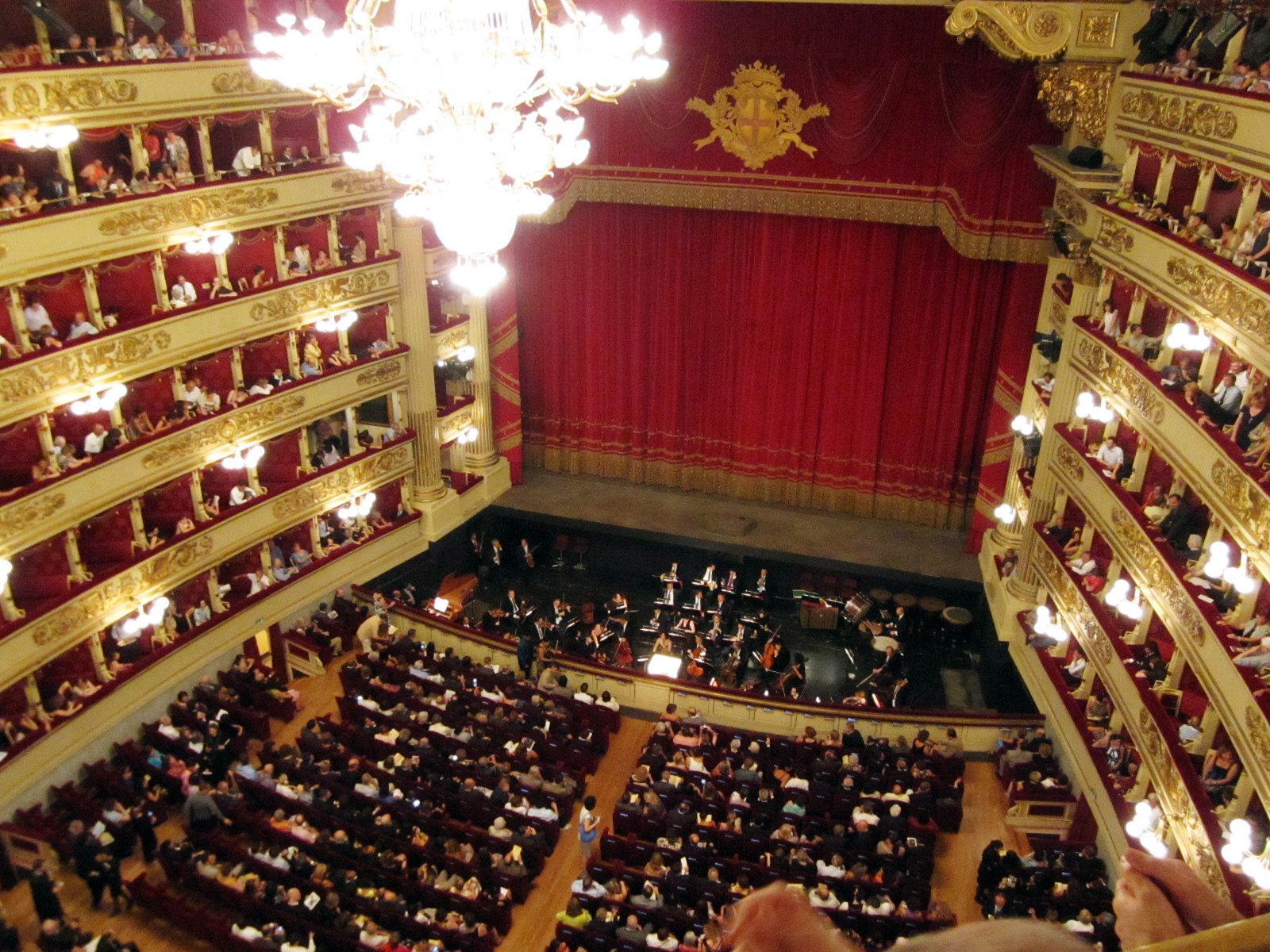 Lucky for us there was a performance of Il Barbiere di Siviglia (The Barber of Seville) by Gioachino Rossini. We went to the box office and yes, there were a few seats left for €220 Euros each. Yikes!! Gretchen read something about the night ticket window that offered tickets at €12 Euros each for the first 140 people in line. The Opera started at 8pm. We showed up at the Biglietteria Serata (the night ticket window) at 5:30pm and there were at least 140 people already in line. A woman handing out numbers motioned for us to be patient and wait and sure enough, we ended up with ticket numbers 136 and 137. We took the elevator up to the top gallery. The seats were in the very back row but if we stood up we could see everything except the orchestra. The sound in the hall was magical. The Opera was delightful. The scenery moved into three sets around a massive 60’-70’ turntable. We had enormous smiles for hours watching Figaro help his friend Count Almavira win the hand of the beautiful Rosina away from her overbearing guardian Dr Bartolo.
Lucky for us there was a performance of Il Barbiere di Siviglia (The Barber of Seville) by Gioachino Rossini. We went to the box office and yes, there were a few seats left for €220 Euros each. Yikes!! Gretchen read something about the night ticket window that offered tickets at €12 Euros each for the first 140 people in line. The Opera started at 8pm. We showed up at the Biglietteria Serata (the night ticket window) at 5:30pm and there were at least 140 people already in line. A woman handing out numbers motioned for us to be patient and wait and sure enough, we ended up with ticket numbers 136 and 137. We took the elevator up to the top gallery. The seats were in the very back row but if we stood up we could see everything except the orchestra. The sound in the hall was magical. The Opera was delightful. The scenery moved into three sets around a massive 60’-70’ turntable. We had enormous smiles for hours watching Figaro help his friend Count Almavira win the hand of the beautiful Rosina away from her overbearing guardian Dr Bartolo.
It’s really hot here. In fact it’s been really hot everywhere, temperatures soaring into the mid 90’s and humidity like I haven’t experienced since in left New Orleans in 1985.
 We’ve been experiencing all kinds of things from the heat, sweating for one, something we rarely do in the cool foggy San Francisco. Our shirts are covered with salt. We had no idea we had this much salt in our bodies. Our nails and hair are growing at such an accelerated rate that we decided to get haircuts in Milan. There is a Designer Hair Salon a few doors down from the hotel.
We’ve been experiencing all kinds of things from the heat, sweating for one, something we rarely do in the cool foggy San Francisco. Our shirts are covered with salt. We had no idea we had this much salt in our bodies. Our nails and hair are growing at such an accelerated rate that we decided to get haircuts in Milan. There is a Designer Hair Salon a few doors down from the hotel.
Although I asked the haircutter to only cut 2 to 3 centimeters off, and my Italian is pretty good, I ended up with a haircut I haven’t had since I was 15 years old. I don’t think I’ve seen the top of my ears in close to 40 years. But after the initial shock, I realized how great it was for the heat. The haircutter kept telling me she knew what I wanted and she would give me the perfect summer haircut. She did. We learned not to argue with an Italian holding a pair of shears.
Pinacoteca di Brera
The Palazzo Brera was build over the 12th century convent of an obscure Italian religious order known as the Humiliati. When they were disbanded in the 16th century the Palazzo went to the Jesuits who added an Astronomical Observatory and amassed an amazing library. Both (library and observatory) are still there. In 1776, the Jesuits were disbanded and the Palazzo went to Maria Teresa of Austria, the mother of Marie Antoinette, who added to the library and started the amazing art collection now known as the Pinacoteca di Brera.
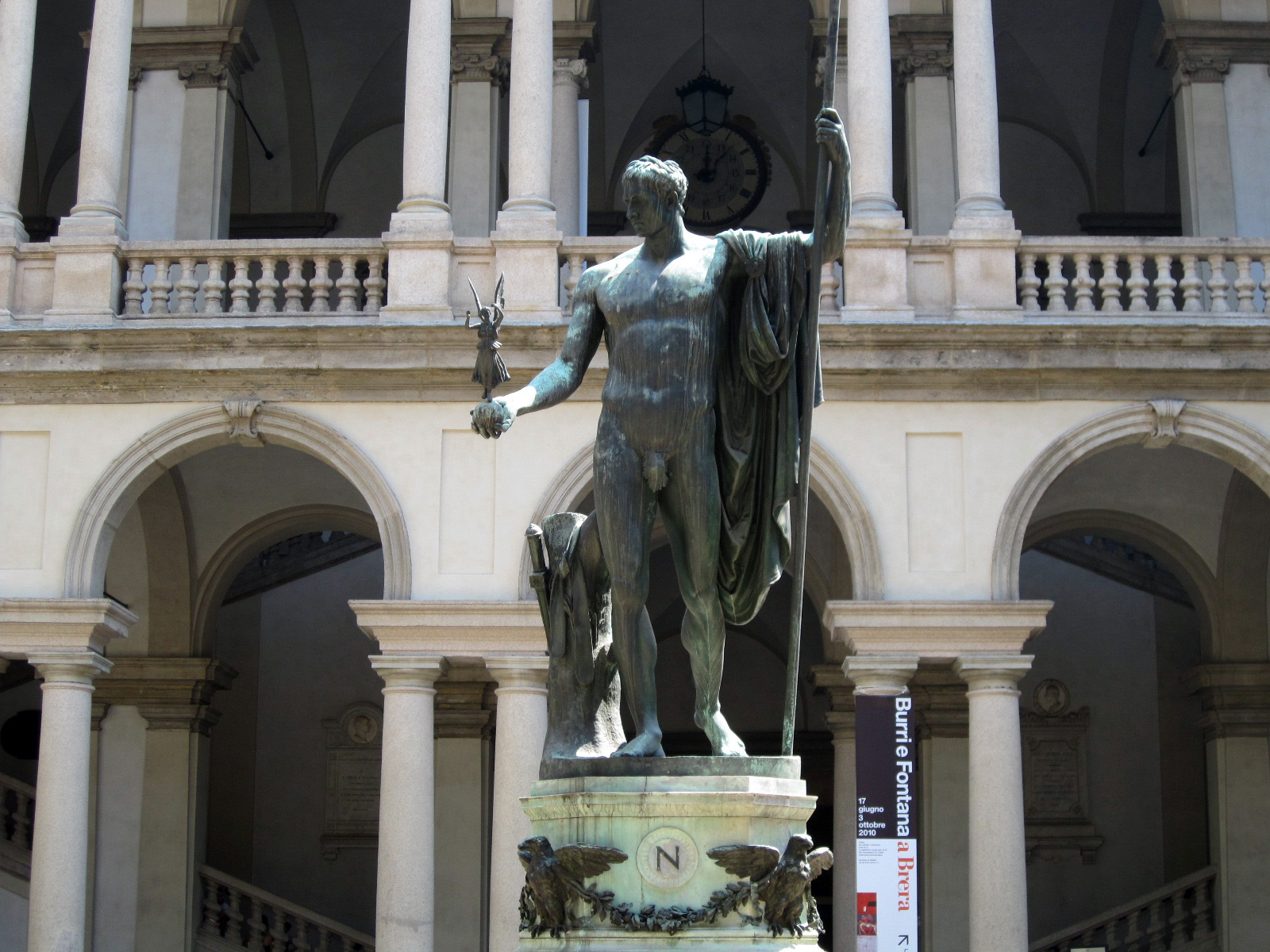 Most of what we see here though was compiled by Napoleon from 1799 to 1808. The Emperor, in fact, greets you in the entry courtyard as a bare assed classical figure holding a scepter in one hand and a globe with a winged victory in the other. The 1806 original marble statue (by Antonio Canova) was deemed too pornographic and it was exiled to the basement of the Louvre, eventually ending up at Apsley House in London as a gift from the French to the British after Wellington defeated Napoleon. The current 1812 bronze version. commissioned by Napoleon’s nephew was put in the courtyard. After the defeat of the Emperor, it was exiled to the basement. It came out again in 1859 to greet Napoleon III. The globe and winged victory is actually a copy. The original was stolen in 1978.
Most of what we see here though was compiled by Napoleon from 1799 to 1808. The Emperor, in fact, greets you in the entry courtyard as a bare assed classical figure holding a scepter in one hand and a globe with a winged victory in the other. The 1806 original marble statue (by Antonio Canova) was deemed too pornographic and it was exiled to the basement of the Louvre, eventually ending up at Apsley House in London as a gift from the French to the British after Wellington defeated Napoleon. The current 1812 bronze version. commissioned by Napoleon’s nephew was put in the courtyard. After the defeat of the Emperor, it was exiled to the basement. It came out again in 1859 to greet Napoleon III. The globe and winged victory is actually a copy. The original was stolen in 1978.
By 1815 the museum had more than 800 works. Luckily (for the Brera) after the fall of Napoleon the art remained in the museum. It’s an amazing collection, mostly for Venetian and Lombard painters from the 13th to the 19th centuries. We bought the audio guide along with the tickets and followed the tour the way the museum laid it out, starting with the 15th century frescos from the Sforza Castle painted by Donato Bramante (possibly the most famous of the Renaissance architects) and on through the countless alter pieces, mother and child portraits, the deaths of various Saints and of course the death of Christ. The most famous of these is the forced perspective of the “Dead Christ” by 15th century Venetian Painter Andrea Mantegna.
We sat in wonder at the Bellini brothers, Gentile and Giovanni) giant imagination of St Mark preaching in Alexandria before his sentencing to death. It’s an imagined world of an exotic Egypt with monkeys, mosques, camels and brown giraffes.
There is a 15th century alter piece by the Venetian, Carlo Crivelli created of paint and gold. The brush strokes so delicate the skin on the figures looks real. It’s so unlike any other Venetian 15th century painting that usually used a wider more impressionistic brushstroke.
There are strange representations of St Peter Martyr, a local Lombard Dominican Inquisitor who was killed by two Cathar assassins in the 13th century. One put an axe into his head, the other put a sword into his chest. St Peter the Martyr is all over the Brera wearing the axe like a strange hat. It’s so weird, you barely notice the sword handle coming out of his chest.
 And at the end of the tour is the most wonderful “Kiss” by the 19th century Venetian painter, Francesco Hayez. Two lovers dressed in medieval clothing are embraced are in a long passionate kiss. The painting has become the symbol of the Italian Romantic period of the mid 1800’s.
And at the end of the tour is the most wonderful “Kiss” by the 19th century Venetian painter, Francesco Hayez. Two lovers dressed in medieval clothing are embraced are in a long passionate kiss. The painting has become the symbol of the Italian Romantic period of the mid 1800’s.
Supposedly, the red clothing and green cap feather worn by the man symbolize the Italians of the Risorgimento fighting for a united Italy. The blue worn by the woman symbolizes France, who in the year of the painting made an alliance with King Vittorio Emanuele II, the future King of united Italy.
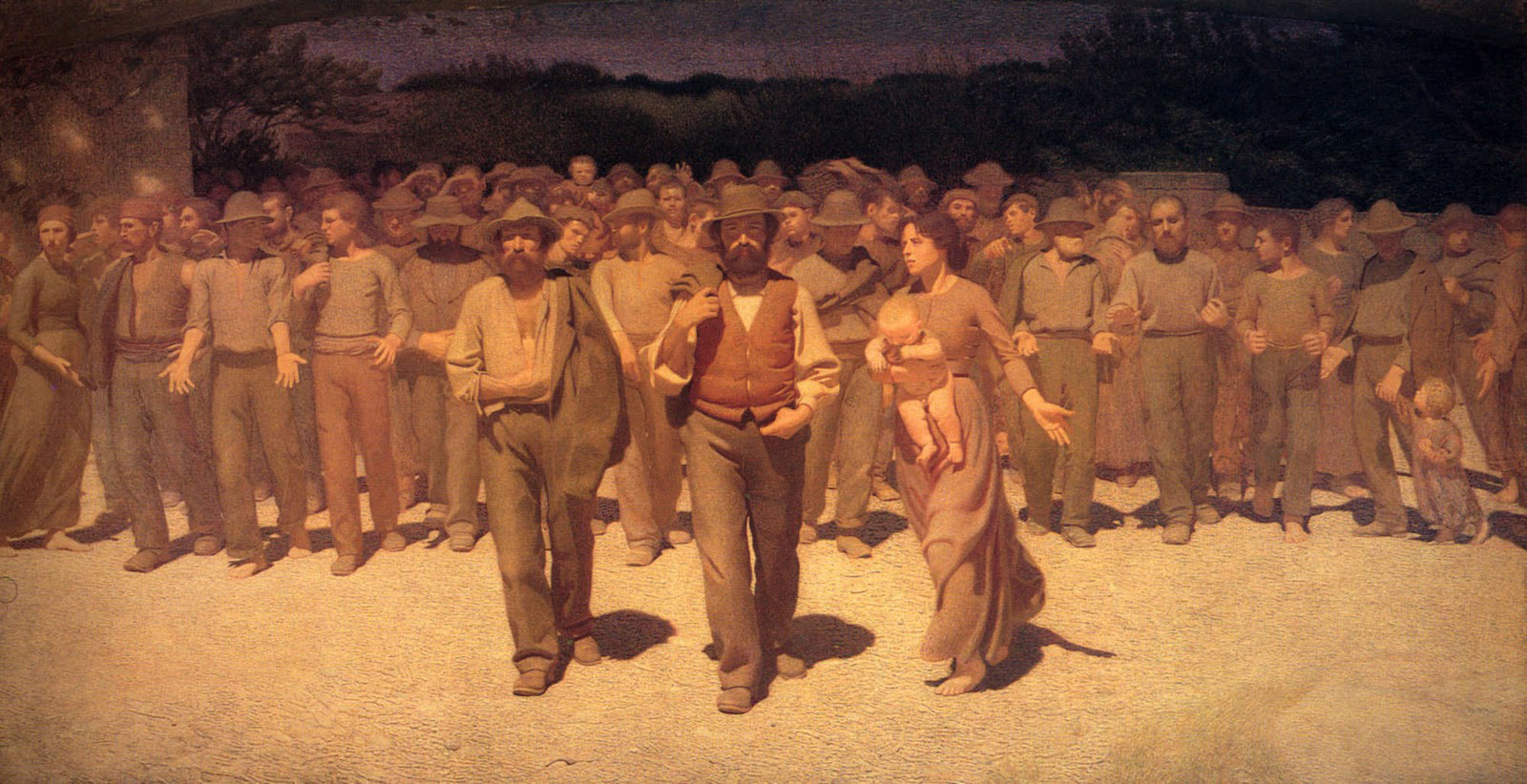 In all of the romantic imagery of “The Kiss”, the real symbol of the 19th century is captured on the following wall in Giuseppe Pellizza painting “Quatro Stato” (the fouth estate). This painting went on to become the symbol of the 19th century poor working class.
In all of the romantic imagery of “The Kiss”, the real symbol of the 19th century is captured on the following wall in Giuseppe Pellizza painting “Quatro Stato” (the fouth estate). This painting went on to become the symbol of the 19th century poor working class.
 Castello Sforzesco
Castello Sforzesco
When the Sforza family inherited the title of Duke of Milan from the Visconti family in the mid 1400’s, they also got the Castello Sforzesco. The Sforzas were fearful, violent, warrior class of people. Galeazzo Maria Sforza (1444-76) once executed a rabbit poacher by making him eat the entire hare, fur and all. He was known to pull the limbs from his enemies with his bare hands and bury them alive. Needless to say, the people rejoiced when he was assassinated.
He was succeeded by Gian Galeazzo Sforza who was poisoned at age 25, supposedly by his uncle Ludovico the Moor, who took over the throne. He was called the Moor because of his dark skin.
Ludovico Il Moro was the man who brought Leonardo Da Vinci to Milan. Interestingly enough, in 1481 Leonardo wrote to Ludovico for a position in the court as a musican/Lyre player. In the letter he also mentioned his ability to design war machines and at the end of the letter he added that if needed, he could also paint. Aside from the Last Supper, he also painted Ludovico’s favorite mistress Cecilia Gallerani as the “Lady with an ermine” (now in Krakow).
The castle is really big and in surprisingly good condition. You could easily spend a half-day here. The exhibits include sculpture, furniture, clothing, and a massive hall of ancient musical instruments, coins, the Egyptian collection, photographs, paintings and the grand living quarters of the royal family. All this for a mere cost of 3 Euros a ticket.
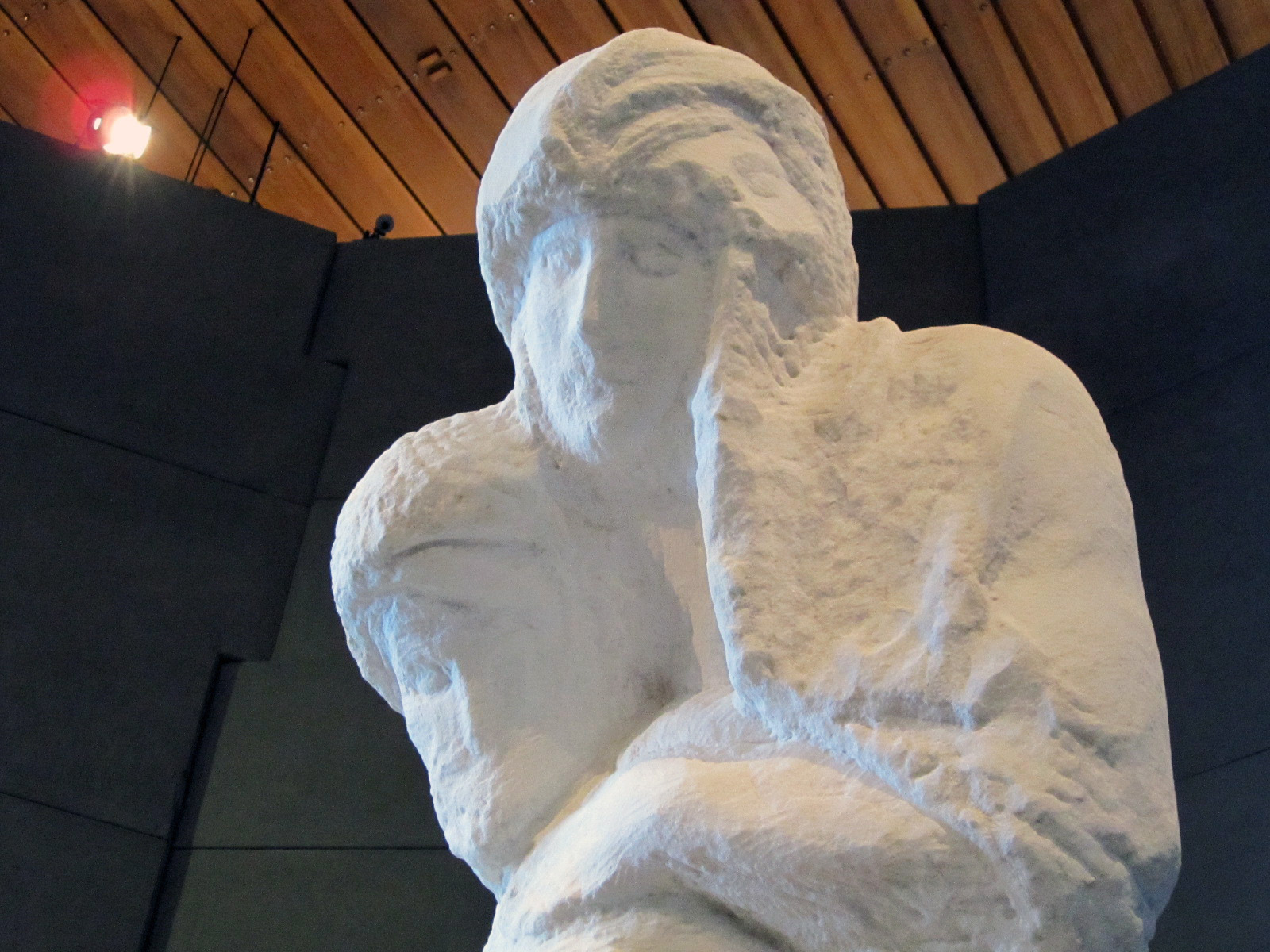 The most famous piece of the collection is the unfinished Pietà Rondanini by Michelangelo. This was the last piece he worked on before his death in 1564. It’s a rough form of the Virgin Mary mourning the death of Christ. It was a work in progress. Michelangelo changed his mind. The original face of the Virgin Mary is looking out to the left. The revised face is looking down. The sculpture actually has two faces of Mary. Maybe Michelangelo was trying to say something else?
The most famous piece of the collection is the unfinished Pietà Rondanini by Michelangelo. This was the last piece he worked on before his death in 1564. It’s a rough form of the Virgin Mary mourning the death of Christ. It was a work in progress. Michelangelo changed his mind. The original face of the Virgin Mary is looking out to the left. The revised face is looking down. The sculpture actually has two faces of Mary. Maybe Michelangelo was trying to say something else?
Many reading this Milan visit might wonder why I left out a visit to the Convent of Santa Maria della Grazie to see “The Last supper” by Leonardo Da Vinci. We highly recommend seeing it. The lines are long, the security takes time and the visit is short but it’s an amazing piece and a great restoration finished in 1999. Although some refer to it as a fresco, it’s really not. Leonardo painted it when the plaster was dry which is why it deteriorated faster than a fresco painted into wet plaster. The painting has endured Napoleon’s troops, prisoners, Allied bombings during World War II and countless really bad paint-overs and restorations. It’s amazing it’s still here at all.
We saw it in 1998 when the restoration was almost completed. It was really exciting to see the artists restoring it. I know we’ll make another visit to it soon. We just never got to it on this trip.
You must be logged in to post a comment.